hankyoreh
Links to other country sites 다른 나라 사이트 링크
[Korea travels] With blossoms from sea to DMZ, there’s nothing like springtime in Korea
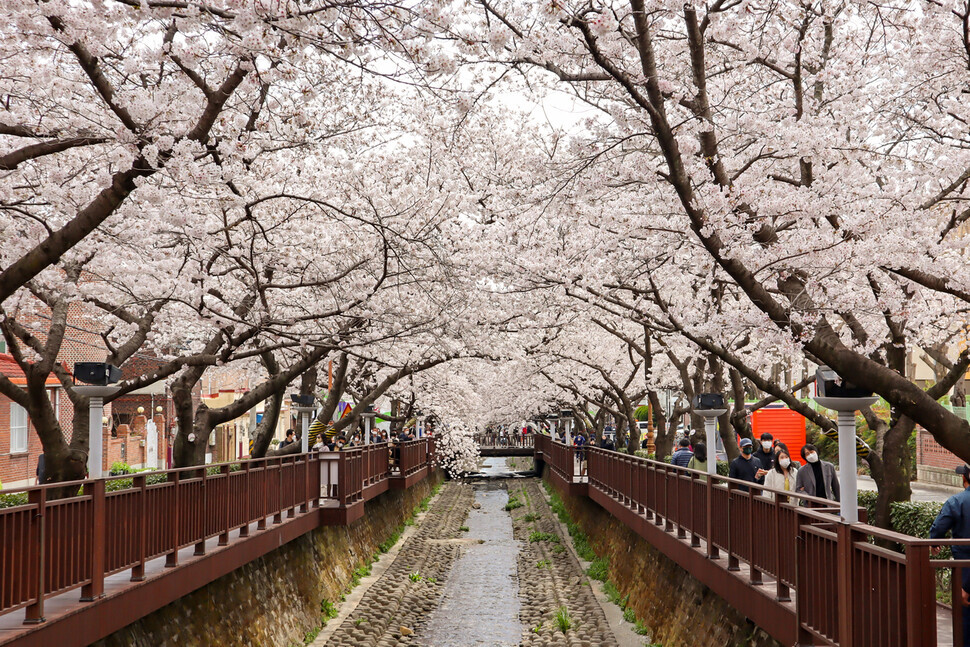
In my travels around the world, I’ve been to one country where the spring is exceptionally beautiful.
Once the flowers start blooming at its southern border, a wave of all sorts of blossoms moves north to cover the entire country over the following month. When the spring winds showered me in petals, it was like paradise.
For that reason, I once traveled from south to north, following the speed of the blossoming flowers. It was the most beautiful journey of my life.
Now that spring has arrived, I found myself wanting to make such a journey again. Deciding it would be better to just get to it rather than to make some kind of a “wish list,” I put my plan into action at once.
Oh, you’re wondering which country it was that had the most beautiful spring? It was Korea.
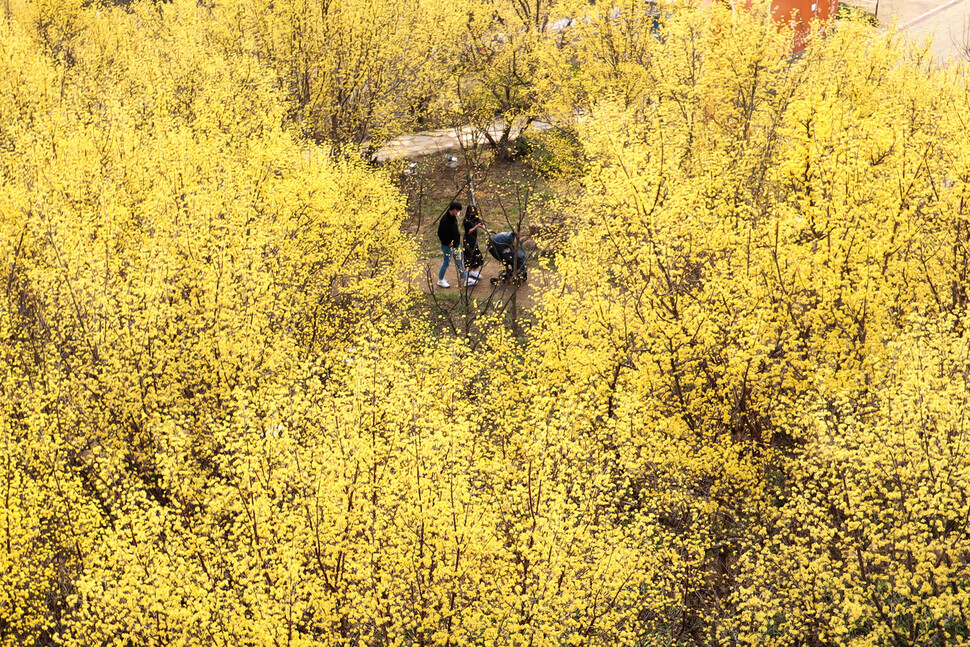
Hitting the road with my sleeping bag, mat, and coat rammed into my rundown car, I arrived at the village of Sandong by Mount Jiri.
I seem to remember hearing that its name came from Shandong in China, the home province of the bride arriving with a dogwood tree in tow. Over the generations, that tree bore offspring that now coat the village in yellow flowers.
After spending the day roaming through the shade of the flowers, I walk through the dogwood blossoms of the park after sunset before finding a place to sleep on Mount Jiri — dreaming of a shower of yellow petals.
The next day, I headed to Gwangyang in order to see apricot flowers. The sweet scent of flowers overwhelmed me as I entered Daap township with the Seomjin River next to me. Walking in the rain in the misty apricot flower-covered village felt like walking under a sky cascading petals. But, if you took a step back and took in the view, you would feel as if you were looking down on a village covered in mid-winter’s snow.
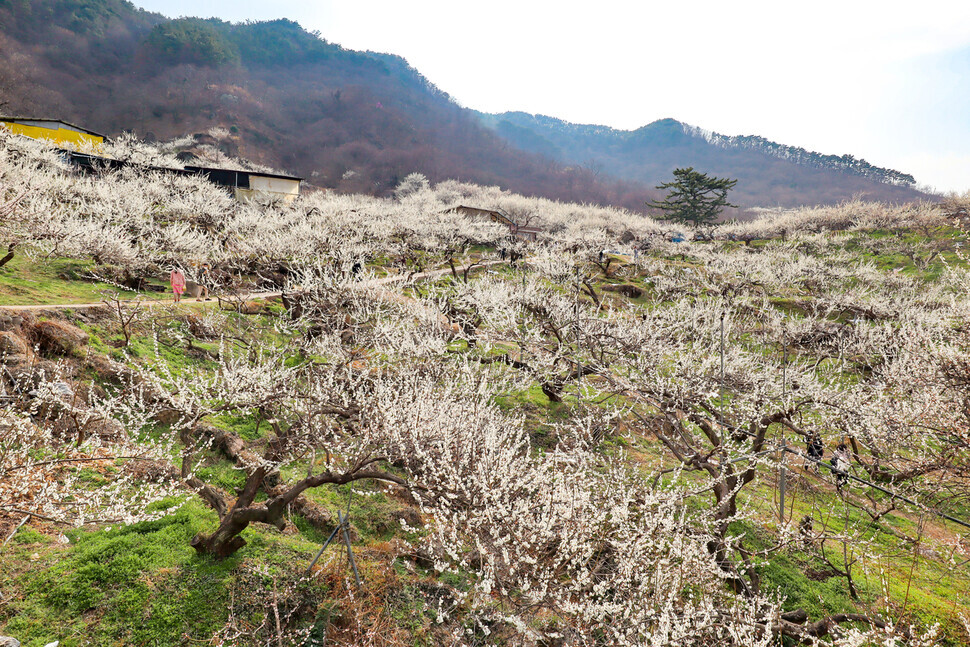
The spring breeze swayed the flower blossoms, making them sprinkle their fragrance upon springtime picnickers. Having flocked to the village to enjoy the magnificent sight of fully bloomed flowers only available once a year, the picnickers peeled off their thick overcoats like flower buds bursting, giggling and laughing.
The following day’s destination was Yeojwacheon Stream in Jinhae. The media had predicted that cherry blossoms would bloom earlier than usual in the area. But a couple of days had already passed since the day flowers were due to have bloomed, but cherry trees had still not blossomed near the stream, their flower buds still unripened.
In the end, I had to wait five more days for cherry blossoms to fully adorn Yeojwacheon Stream after a spring rain came and went. Flower petals floated in the air, falling to the ground at a speed of 5 centimeters per second. They fell on the stream’s surface, on steppingstones, and my lips on my upturned face. I was filled to the brim with a heart-throbbing and warm love that made me feel like I had been reunited with a lover back from a long journey. How beautiful you are, I thought as I looked around me.
After being submerged in a landscape of soft pink, my eyes craved different colors. I should be able to see azaleas on Geoje Island, I thought. I went to Mount Daegeum, named thus as it had once produced steel, but also known as the mountain wrapped around with silk because spring azaleas made it look like it was covered with purple silk. When azalea flowers bloom, they feel like tissue paper that would rip at the slightest touch. Perhaps because of this, azaleas feel like letters spring has made grain pains to send to the world secretly, away from watchful eyes of winter. The wind stirred the secret letters as it passed by, as if curious what message the missive contained.

I traveled northward along the Nakdong River. Cherry trees lined the local road that connected Hakpo Waterfront Park with the canola flower field in Namji, showering flower petals endlessly. They rolled around the roadway like small hailstones. I spent the day in the yellow canola flower field, then reached Upo Wetland around sunset. I had a drink with cherry blossoms as my company and fell asleep with the spring in my arms.
The next morning, I took a walk along Upo Wetland’s trail. Passers-by were few and far between, as it was a weekday. I greeted butterflies, flowers, and birds during my walk. I even ran into a raccoon strolling the thickets. I returned to my car after walking about 10 kilometers under the spring sunshine, opening the sunroof to rest a little bit but falling asleep. When I woke up, my face was covered with flower petals. They were as light as the present life that I hadn’t even noticed them falling on my cheeks!
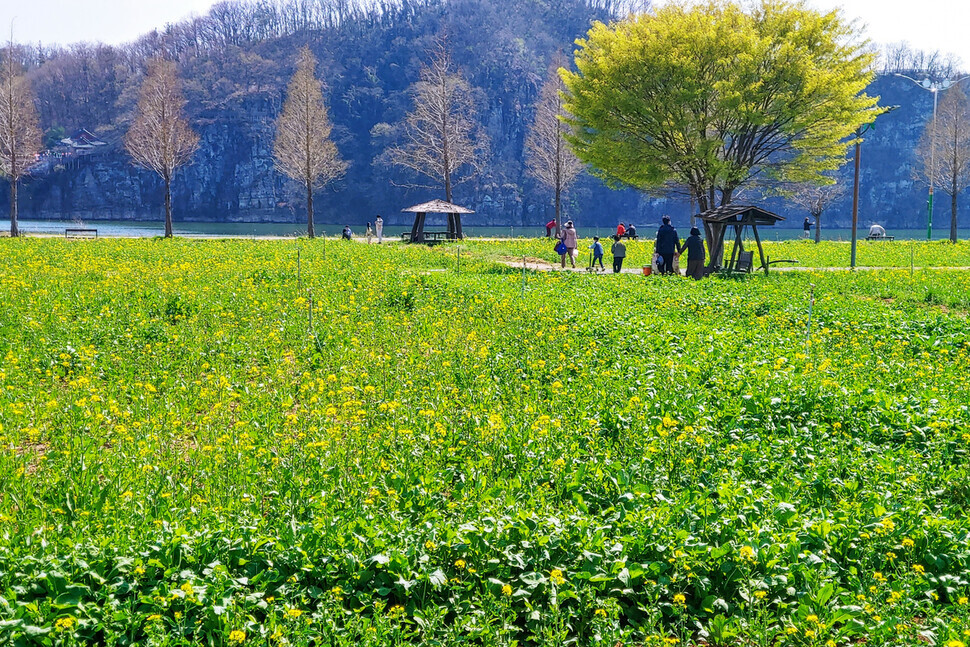
The 100-ri long cherry blossom road started as soon as I entered Hapcheon County, where Haein Temple is located. What was it that bloomed, withered, then fluttered in the air — snow flurries, flowers, or Buddha? Every moment you blossomed within me were flowers that bloomed with popping sounds, the 1,700 koans I held in my arms over the winter bursting in resolution. The path of flowers continued from Hapcheon all the way to Hamyang.
I circled around Mount Deogyu towards Mount Geum. As I enjoyed a drink at a “House with a Courtyard,” I glimpsed redbuds readying themselves to flower nearby. The next day, I paid a visit to the “Rocket Doctor” living in Daejeon. Over drinks, we discussed exploring the moon and traveling to Mars. I wanted to talk about space all night. But I couldn’t hold onto someone who had a business trip scheduled for the next day. Before going to sleep, I recalled the poem “Space” by Jo Dong-heum. “The word space / What a reassuring word / Every being has a home to return to / Even if they're wandering the streets / Without a house / That’s what / Space means.”

I passed by the flower-lined road at Daecheong Lake and headed towards Mungyeong. The owner of the cabin on Mount Yusu I was staying at had said their sheep had had babies and left for Uijeongbu, so the house was empty except for guests. While the spring wind stirred the landscape, apricot flowers bloomed in the yard, and azaleas covered the hill in the back. “Azaleas already?” someone asked. “I brought them with me!” I said.
After the night wind was done tickling the scenery by early morning, I set off for the day. I was crossing Daegwallyeong Pass when my wife messaged me, “Cherry blossoms have bloomed!” I remembered that when I set off from home, she had asked me when I would return. I had told her, “I’ll be back by the time the cherry tree in front of our house has bloomed!”
I reached Sokcho, the northernmost city in South Korea. South Korea’s northernmost city where Ulsanbawi Rock, as sharp as dinosaur teeth, blended in with the blue lake and sea resembled Patagonia, the southernmost city of the earth. It was like Punta Arenas, El Chalten, and Ushuaia. I met my wife underneath a cherry tree and set off on our journey. Yeongnang Lake was encircled by a pink frill. I knew I had to hurry up in order to say goodbye to the flowers moving north.
I drove further north with the sea on my right. I crossed Songjuk Bridge, looking towards the ocean. That was where the pine forest was — the one that I liked. I remembered the first time I entered that forest. It was 2 kilometers-long along the coast. I was usually disappointed by it because the forest and the beach were divided by a barbed-wire fence. But unlike the other times I had visited, the beach was exposed clearly. Doubting myself, I hooked a right and drove down an access road. The fence was gone!

Two foreigners were unloading unusual equipment from their trunk on the beach. “…Hello?” I said. Their faces turned cautious. I better reveal that I wasn’t watching over them, I thought. “Hi! My name is Rho, and I’m a travel writer,” I introduced myself. Their expressions relaxed. The conversation went on: “Is that a metal detector?”; “Yes”; “What are you looking for?”; “We’re looking for remnants of the Korean War and items that floated down from North Korea. Today, we found a treasure!” Bart and Art showed me rusted cartridges and products manufactured in North Korea.
“We started this as a hobby. When we discover items from North Korea, we imagine, ‘Who drank this drink — a kid or an old lady?’ North Korea is a country that’s at once far away and close. We don’t know much about politics, but we hope full-blown peace is established, not a half-baked one. If South and North Korea grow together and help each other out, they’ll become much more impressive countries. United Korea — the idea alone sounds awesome!”
According to a YouTube video Bart had posted, his friend who had studied abroad at Kim Il-sung University said North Korean students were incredibly curious about South Korea. “They were especially curious about South Korea in 2018, [when the inter-Korean summit at Panmunjom took place.] We could feel how curious and optimistic they were about South Korea. Some of them asked [our friend] for pictures. Because there isn’t direct contact or photos, it was hard for them to visualize what South Korea is like. So [my friend] showed them a lot of pictures. They seemed happy to see [the photos]. Like, ‘Wow, is that also our country?’”
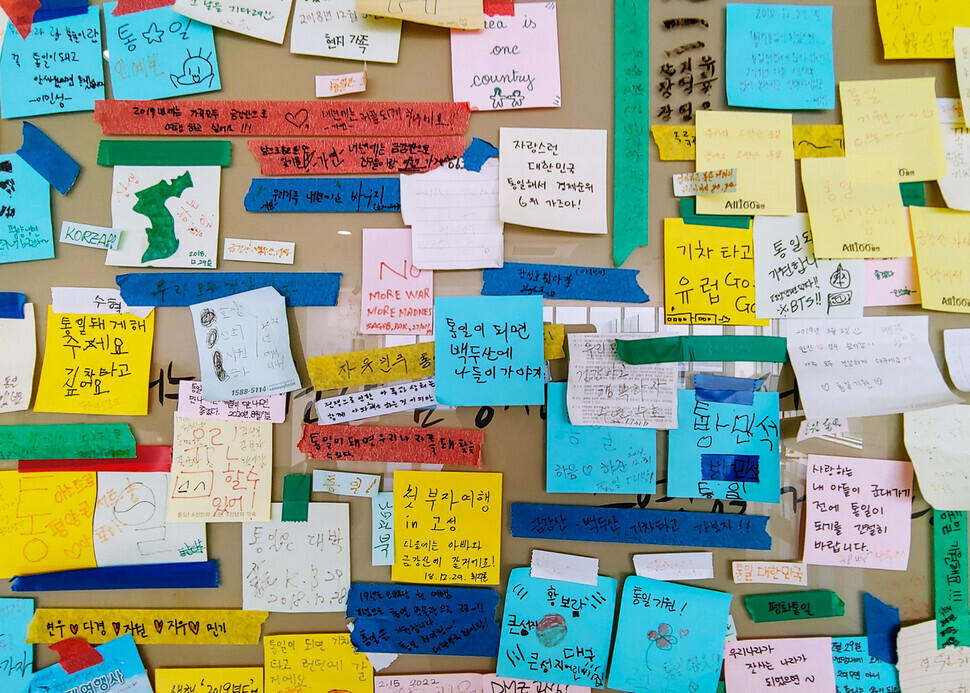
I passed Daejin and filled out an entry form. Forsythias, magnolias, and cherry blossoms had arrived at the border before me. I went up the Unification Observatory and looked towards the north. I felt like an early human who had gone from Africa to Asia, across the Bering Strait to America, then down to Patagonia until there was nowhere else to go except the ocean. The DMZ felt like the cold, rough sea. Like a South Pole North Korea could pass only by pushing through with an icebreaker.
“Spring. Because I wanted to spend time with you as long as possible, I came to meet you and followed you for half a month, but now I can’t trail you anymore. Now, you will bloom flowers in Kaesong, Wonsan, and the Kaema Plateau,” I thought. Flowers and the green continued northward while I remained all by myself. I burst out crying. A late-to-bloom flower bud eyed me as I wept.
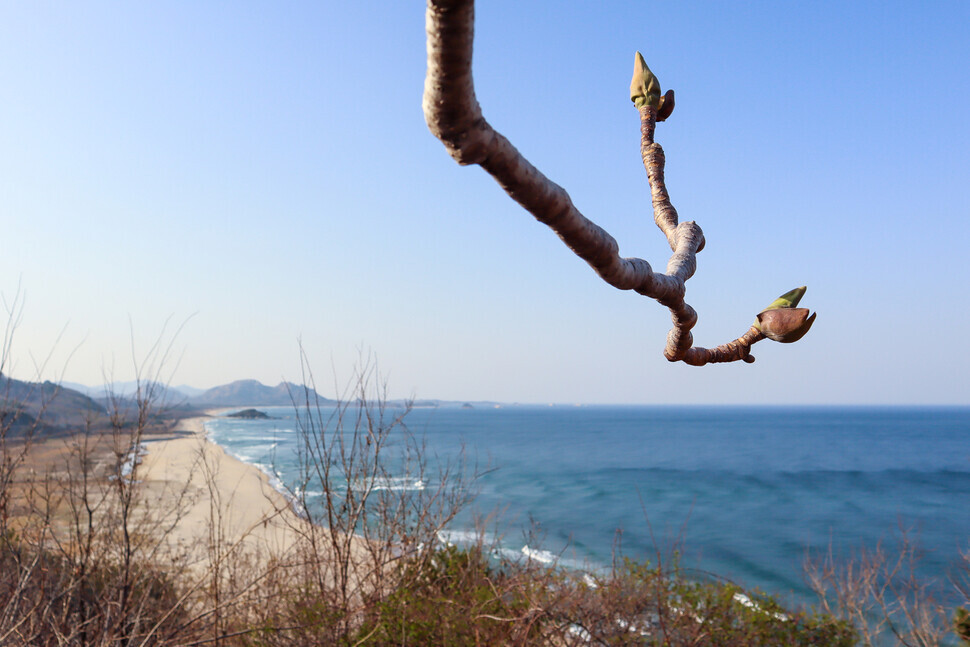
Travelers of this land who are born with a nomadic temperament dream of taking a road trip beyond the Tuman and Apnok Rivers, to Europe and Africa. The path to such a journey already exists. You can take a ship to Vladivostok or the Shandong Peninsula with your car, and then start your epic road trip from there. But why should you do that when Korea is not an island country?
The Korean word for “abroad” combines the Chinese character for “sea” (hae) with the Chinese character for “outside” (oe). The word — “haeoe” — is often used to modify “travel,” “advance,” “products,” “study,” and “visit.” But it’s a word suitable for use by island countries that are not connected with other countries by land. But somehow, that’s the word Koreans use. It might be a word transplanted during the Japanese colonial period, or when Japanese books were translated into Korean after Korean independence.
But the Korean Peninsula is not an island. The word “gukoe” — which literally means “outside the country” — is a more appropriate term for us. But might we be using the word “haeoe” without questioning it because the DMZ is a sea by another name? Language is the house of being. We should tear down the barbed-wire fence of “haeoe” before the word imprisons us.
I still have a dream I haven’t realized. It is to follow the trail of spring flowers beyond Mount Paektu and arrive at Finland, where I would witness the largest, most brilliant flower on earth — auroras!
By Rho Dong-hyo, author and travel writer
Please direct questions or comments to [english@hani.co.kr]

Editorial・opinion
![[Editorial] Intensifying US-China rivalry means Seoul must address uncertainty with Beijing sooner than later [Editorial] Intensifying US-China rivalry means Seoul must address uncertainty with Beijing sooner than later](https://flexible.img.hani.co.kr/flexible/normal/500/300/imgdb/original/2024/0517/8117159322045222.jpg) [Editorial] Intensifying US-China rivalry means Seoul must address uncertainty with Beijing sooner than later
[Editorial] Intensifying US-China rivalry means Seoul must address uncertainty with Beijing sooner than later![[Column] When ‘fairness’ means hate and violence [Column] When ‘fairness’ means hate and violence](https://flexible.img.hani.co.kr/flexible/normal/500/300/imgdb/original/2024/0516/7417158465908824.jpg) [Column] When ‘fairness’ means hate and violence
[Column] When ‘fairness’ means hate and violence- [Editorial] Yoon must stop abusing authority to shield himself from investigation
- [Column] US troop withdrawal from Korea could be the Acheson Line all over
- [Column] How to win back readers who’ve turned to YouTube for news
- [Column] Welcome to the president’s pity party
- [Editorial] Korea must respond firmly to Japan’s attempt to usurp Line
- [Editorial] Transfers of prosecutors investigating Korea’s first lady send chilling message
- [Column] Will Seoul’s ties with Moscow really recover on their own?
- [Column] Samsung’s ‘lost decade’ and Lee Jae-yong’s mismatched chopsticks
Most viewed articles
- 1[Editorial] Transfers of prosecutors investigating Korea’s first lady send chilling message
- 2For new generation of Chinese artists, discontent is disobedience
- 3S. Korea “monitoring developments” after report of secret Chinese police station in Seoul
- 4Xi, Putin ‘oppose acts of military intimidation’ against N. Korea by US in joint statement
- 5[Exclusive] Unearthed memo suggests Gwangju Uprising missing may have been cremated
- 6N. Korean media upgrades epithet for leader’s daughter from “beloved” to “respected”
- 7Yoon says concern about biased diplomacy is being incited by “communist totalitarian forces”
- 8[Editorial] Intensifying US-China rivalry means Seoul must address uncertainty with Beijing sooner t
- 9[Column] Samsung’s ‘lost decade’ and Lee Jae-yong’s mismatched chopsticks
- 10[Special reportage- part I] Elderly prostitution at Jongmyo Park